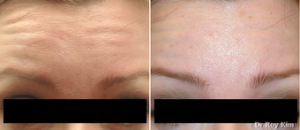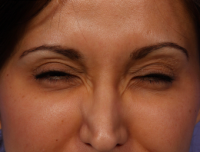Avoiding The Bad Botox Is Easy
There is a LOT of BAD BOTOX out there. But it is so easy to avoid it. Easy answer – Be Smart. Just get your Botox from a REPUTABLE physician ; either Plastic surgeon, Dermatologist or a Facial Plastic surgeon.
Do NOT get it in a salon, a “Botox Party” or from another MD (such as a family practitioner etc), DO (osteopath) or DC (chiropractor).
Personally – I KNOW that a DOCTOR can always do a better job than the vast majority of “injectors” out there so I would recommend you not go to offices that use injectors but rather where the Plastic surgeon, Dermatologist or Facial Plastic surgeon himself/herself does the Botox injecting. (Peter A. Aldea, MD, Memphis Plastic Surgeon)

32 Year Old Woman Treated With Botox Before And After By Dr. Marguerite A. Germain, MD, Charleston Dermatologic Surgeon
Botox is safe if the physician is experienced and artistic.
If properly done by an experienced, careful, creative, and artistic board-certified dermatologist or plastic surgeon, there should be no trouble.
Side effects can occur from use of too much Botox, improperly placed Botox, or poking a blood vessel, which can lead to a small bit of bruising.
For a first time treatment, it is perfectly fine to ask your doctor to be conservative so you can get used to the effects of a small amount until you feel comfortable returning for a touchup to full effect. (Jessica J. Krant, MD, MPH, New York Dermatologic Surgeon)
Although Botox is generally very safe, unwanted side effects including droppy eyebrows or eyelids can occur. The good news is that there are not permanent – Botox is generally out of your system in 3-4 months.
39 Year Old Man Treated With Botox For Moderate To Severe Crow’s Feet Wrinkles Before And After With Doctor John Mesa, MD, New York Plastic Surgeon
The number one way to minimize your risk of side effects is to see a physician who is well-trained and well-informed. (Reena Rupani, MD, New York Dermatologist)
Botox Complications, avoiding problems
Botox does not have many side effects, but the more common side effects are bruising and inflammation, which are always a risk for any type of injection. These side effects can’t be totally prevented, but abstaining from taking any ibuprophen, aspirin, vitamin E, St. Johns Wart and alcohol for one week prior to injection and being treated by an experienced medical professional can lower the risk. Choose your injector carefully. Look for someone experienced. Most plastic surgery practices offer a complimentary consultation.
Only proceed with a Botox injection if you feel completely comfortable with the the practice and the injector. Always communicate with your plastic surgeon’s office. They will want to know if you have any type of complication and there is help. (Michael Law, MD, Raleigh-Durham Plastic Surgeon)
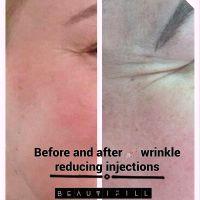
Before And After Wrinkle Reduction Injection
To avoid complication, begin with limited areas and experienced injector.
Few complications come in the hands of experienced injectors when the injections are limited to the areas about the lids. However, complications are more frequent when doing the mouth, neck, etc. Therefore, we begin first time patients in limited areas and very carefully diagram areas treated and amounts used.
From the initial response we can modify what we will later do. (Nathan Mayl, MD, Fort Lauderdale Plastic Surgeon)
Botox side effects
The most common side effects of Botox include mild discomfort at the site(s) of injection, temporary redness at the injection site and possible bruising. Rarely, patients may experience a headache. The incidence of an eyelid droop is very rare occurring in about 1% of patients. It is temporary and usually resolves in a few weeks. (Lori Stetler, MD, Dallas Dermatologic Surgeon)
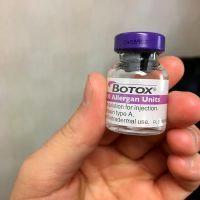
Botox Can Be Dangerous If It’s Administered Incorrectly
Droopy eyelids is a technical problem, not really a complication. Botox was either injected into an incorrect area or it was allowed to spread there. While there is no fool-proof way to avoid technical problems, your best bet to avoid it is to ensure your doctor is well experienced with BOTOX injections. (Martin Jugenburg, MD, Toronto Plastic Surgeon)
Avoid droopy eyelids
While there is no full proof technique to avoid botox side effects, going to an experienced doctor who performs the procedure on a regular basis is a good start.
In addition , if you don’t ask the doctor to ‘over treat’, or inject wrinkles that are too close to the eyebrow, this should lower the risk of an eyebrow droop! (Joshua L. Fox, MD, Long Island Dermatologic Surgeon)
Droopy eyelids can occur if botox is administered too close to the brow. This is very uncommon, but is just a technical problem. I would recommend going to an experienced injector who has a good understanding of facial anatomy.
Also if you are nervous, talk to friends or other people you know that have had it. I personally have been getting botox injections since my late 20’s and really love it’s results. You should feel free to talk to your doctor about any concerns you may have with botox prior to your treatment.
that should make you more comfortable and have a more positive experience (Catherine Huang-Begovic, MD, FACS, Beverly Hills Plastic Surgeon)
Botox: minimal incidence of adverse side effects when administered by an experienced practitioner
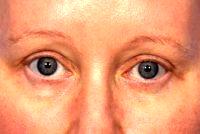
Botox To Crows Feet And Between Eyes (Glabella) Before And After By Doctor Grant Stevens, MD, Los Angeles Plastic Surgeon 78
Certainly I can understand feeling a bit anxious before trying something new. However, rest assured Botox is a very safe procedure when administered by an experienced practitioner. While some practices rely on ancillary staff (usually nurses, but not always) to administer Botox, I prefer to administer it myself, and my patients respond well.
The likelihood of ptosis (eye drooping) is minimal. (Peter Schmid, DO, FAACS, Longmont Facial Plastic Surgeon)
Botox complications
Eyelid ptosis is the biggest concern and probably the most severe complication of botox use. It occurs rarely and if the surgeon is experienced should happen almost never. If it does occur the problem is temporary.
There are no other significant coplications reported with the use of botox. (Richard Galitz, MD, FACS, Miami Facial Plastic Surgeon)

Coreecting Asymmetry With Botox (Dysport Browlift). Before And After With Dr Harold J. Kaplan, MD, Los Angeles Facial Plastic Surgeon
The best way to avoid avoidable side effects is to go to an experienced injector. Droopy eyelids is often an avoidable side effect. While it can rarely happen with proper injection technique in most cases it doesn’t.
I have used Botox for my patients for well over 13 years with very satisfying results. (Carlos Wolf, MD, Miami Facial Plastic Surgeon)
The biggest problem I see is inexperienced injectors who don’t fully understand the facial anatomy and therefore inject all their patients the same way. This does not work. Botox is an art. You have to evaluate each patients facial expressions and muscles and inject each patient in an individualized way.
Also, in my opinion, less is more with botox. Too much botox just looks like too much Botox! (Patricia Farris, MD, Metairie Dermatologic Surgeon)
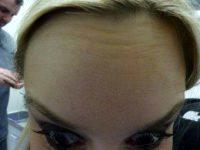
Doctor Samantha Toerge, MD, Chevy Chase Dermatologic Surgeon – Botox- Forehead
I would suggest going to a qualified person who has alot of experience injecting Botox. This usually means a board certified doctor who was trained in facial aesthetics. (Steven Wallach, MD, New York Plastic Surgeon)
Side effects to Botox
First you need to go to a experienced injector. Ask the injector about their training and how long they have been injecting Botox. Botox side effects are typically minimal in nature. You can experience swelling or bruising at the injection site.
Avoid aspirin, ibuphen, vitamin E, and some herbal products to reduce bruising seven days before treatment. Apply ice at the site to minimize bruising & swelling. Make sure the Botox is FDA approved by Allergan. It’s in a box with a hologram on the box with a lot number and expiration date on the bottom of the box.
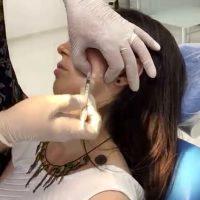
Select Your Doctor Carefully
Botox comes in glass bottle with a purple top. (Vincent N. Zubowicz, MD, Atlanta Plastic Surgeon)
If you choose to go to an experienced and trained dermatologist or plastic surgeon for you botox injections, side effects are quite uncommon. If they were to occur, however, side effects could include bruising (usually resolves in 4-5 days), the occasional headache, and very rarely a drooping of the eyelid or eyebrow.
Drooping typically occurs when too much Botox is injected in one place or when Botox is injected too close to the eyebrow or eyelid. As Botox is not permanent, all these side effects are temporary.
And again, in experienced hands, these problems are unusual, easily correctable, and quickly resolve on their own. (Channing R. Barnett, MD, Boca Raton Dermatologist)
The main tip: use an experienced well-trained injector. Side effects happen, but they are extremely rare. Four specialties are qualified to administer facial cosmetic treatments: facial plastic surgery, dermatology, oculoplastic surgery, and plastic surgery. Choose one of these, but make sure they have years of experience including hundreds if not thousands of patient injections. (Stella Desyatnikova, MD, Seattle Facial Plastic Surgeon)
Botox side effects caused by bad technique.
Botox is extremely safe. But some inexperienced doctors who use Botox may not be safe. The side effects I know about are due to either using too much Botox, or by putting it in the wrong place (like too close to the upper eyelid). (George J. Beraka, MD (retired), Manhattan Plastic Surgeon)
Botox results often depend who is on the other side of the needle
Sure, bruising, drooping and any side effect can happen to anyone. If a doctor has not had dropping with Botox then he/she has not done enough Botox. The key is to find someone with a great understanding of facial anatomy and extensive experiece with Botox.
As a facial plastic surgeon and a platinum provider of Botox I still get some of these things. The good thing is that they are very uncommon and usually very mild. So experience, background and training do matter. (Robert F. Gray, MD, FACS, Bay Area Facial Plastic Surgeon)
How to avoid side-effects with Botox and Dysport
Adverse events after Botox injections received a lot of attention after the FDA mandated a “boxed warning” for both products. The patient Medication Guide lists a range of horrible things such as loss of bladder control or inability to speak; though these messages are required by the FDA, no serious adverse events related to spread of the product beyond the injection site have ever happened with cosmetic doses.
This despite the millions of injections that have been done. One really has to wonder what the FDA’s motives were in requiring the warning. That said, it is wise to make sure that your injector is experienced and using the real thing.
Bad things happened when some doctors bought some botulinum from a lab that normally supplies only research facilities. (Richard Baxter, MD, Seattle Plastic Surgeon)
Any experienced injector who is properly trained and credentialled can minimize or eliminate side effects related to Botox. Botox should be stored properly and used within the prescribed time. Therefore, the physician that you go to must have sufficient patient flow to utilize the product in a timely manner. (Kris M. Reddy, MD, FACS, West Palm Beach Plastic Surgeon)
Easy to administer Botox, difficult to deal with possible complications
There has been a recent review by the FDA of the safety of Botox due to several adverse reactions. From the information provided by the FDA, the adverse events seem to have occurred in children less than 12 years of age and in adults where large quantities of Botox have been administers (100-700 Units).
In the adult group, there were hospitalizations but no deaths or even need for ventilatory support. In my practice, I administer 20 Units of Botox per treatment area and have not administered more than 40 Units at a time.
It is easy to administer Botox; what is difficult is to deal with any possible complications. Be sure to seek treatment from a facility where a trained, experienced physician is either doing the procedure or is readily available in case of problems. (D.J. Verret, MD, Dallas Facial Plastic Surgeon)
Avoid botox side effects by fake or imported product
At this time, the manufacturer of Botox (Allergan) is the only provider of Botox to doctors’ offices in the US (outside of a few other clinical trials). If you were to find someone that has bootlegged a Botox-like product, a copycat from another country, or bought it from a different manufacturer, that would be huge red flag and very dangerous as they might not be using the purified derivative of the Botulism toxin Consult with a reputable plastic surgeon or dermatologist before having the treatment administeredBe careful of non-MD’s performing any medical procedure Make sure they are properly supervised by a credentialed physician if they are performing injections in a spa-type setting. (Jennifer L. Walden, MD, Austin Plastic Surgeon)
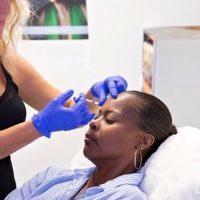
Botox Must Be Used Only Under A Doctor’s Care
The best way to avoid complications with Botox treatment is to consult an experienced dermatologist or plastic surgeon. (Martie Gidon, MD, FRCPC, Toronto Dermatologist)
First, go to someone that is trained and has experience in the injection of Botox. With proper technique most side effects are avoided. (Thomas Guillot, MD, Baton Rouge Plastic Surgeon)
Most of the “side effects” described for Botox are associated with the Botox spreading to adjacent areas that you don’t want to treat. As such, the best way to decrease the risk of side effects with Botox is to seek treatment with a physician with training in anatomy, injection technique and Botox use.
In my opinion you should look for a dermatologist, plastic surgeon, facial plastic surgeon or oculoplastic surgeon with extensive experience in using Botox. (Andrew Kaufman, MD, Los Angeles Dermatologic Surgeon)

